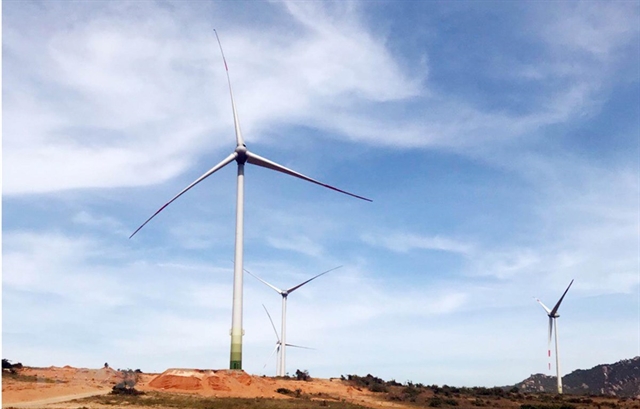 Economy
Economy


|
| A wind farm in Mũi Dinh, Ninh Thuận Province. — VNA/VNS Photo Công Thử |
HÀ NỘI — Việt Nam needs to develop mechanisms, policies, technology and financing to promote the development of clean energy projects as the country moves towards carbon neutrality.
Attendees explored the future of the country's energy sector at a conference on Thursday in Hà Nội.
The second Việt Nam Clean Energy Forum was co-organised by the Department of Climate Change, the Institute of Energy, the Science Council of Vietnam Energy Magazine and the Energy Information Centre, aiming to discuss problems, challenges as well as opportunities and recommend policies for clean energy development.
Phạm Văn Tấn, Deputy Director of the Department of Climate Change under the Ministry of Natural Resources and Environment, said Việt Nam committed at the United Nations Climate Change Conference in November 2021 (COP26) to reach the net-zero carbon emissions target by 2050.
The Ministry of Natural Resources and Environment was developing a national strategy on climate change to 2050, in which, detailed solutions would be raised to bring net carbon emissions to zero, Tấn said, adding that replacing coal-fueled power generation with wind, solar and gas-fired power was a current trend.
To date, the total installed capacity of renewable energy sources was estimated at around 20.7GW, accounting for 27 per cent of the total installed capacity of the power system.
However, the rapid development of wind and solar power projects in recent years resulted in a regional imbalance between generation and transmission as these projects were mainly located in the country’s central and southern areas, Hoàng Trọng Hiếu, Deputy Chief of the National Steering Committee for Electricity Development’s Office said.
Hiếu said that the implementation of clean energy projects was currently facing problems related to planning, financing, site clearance, and feed-in tariff policies.
Currently, renewable energy projects were concentrated in some provinces, putting pressure on the national power grid and causing an increase in investment costs.
Regarding financing, renewable energy projects often had huge investments while the output largely depended on the weather and climate conditions, thus, credit institutions tended to be hesitant in providing lending to renewable energy projects as it often took a longer time to recover capital.
According to Phạm Thị Thanh Tùng, Deputy Director of the Credit Department under the State Bank of Việt Nam, the total outstanding loans for green projects reached more than VNĐ441 trillion by the end of 2021, or 4.2 per cent of the total outstanding loans in the economy and up by 32.5 per cent against 2020.
The outstanding loans for clean energy projects were estimated to total around VNĐ212 trillion.
Tùng said credit institutions were hesitant to lend to clean energy projects because of a number of factors that affected the efficiency of the projects such as electricity price, capital recovery time, weather conditions and the transmission system capacity.
It was necessary to establish a renewable energy fund to raise financial resources for the development of clean energy projects in Việt Nam, she said.
Huge capital
Speaking at the forum, Nguyễn Mạnh Cường from the Institute of Energy under the Ministry of Industry and Trade, said that to achieve the net-zero target by 2050, the power source structure must be changed, meaning that it required an increase of 33 per cent in investment which would lead to an increase of 30 per cent in electricity prices.
In the net-zero scenario, coal-fired power generation would be gradually phased out and replaced by renewable sources. The proportion of renewable energy capacity would be increased to 32 per cent in 2030 and 58 per cent in 2045, which would require huge investment.
He also pointed out that the transmission network must also be upgraded to transmit power from the central region to the north.
To achieve net-zero, Việt Nam would need US$532 billion investment in generation and transmission in the 2021- 45 period, compared to $400 billion in the normal scenario, a big challenge for the economy.
According to Phạm Nguyên Hùng, Deputy Director of the Electricity and Renewable Energy Department under the Ministry of Industry and Trade, renewable energy would play an important role in the country’s industrialisation and modernisation process.
The ministry was studying policies and mechanisms to promote the development of renewable energy, including amending the Law on Electricity. — VNS